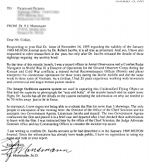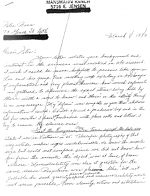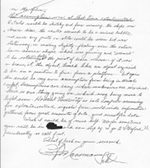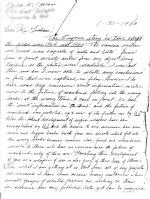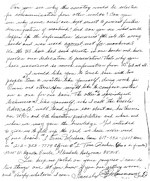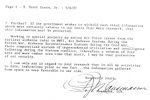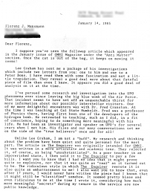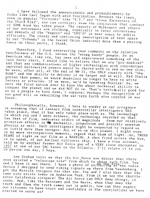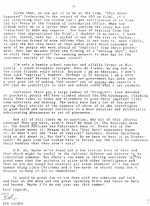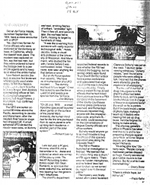Articles
Deep Denial or Disinformation?
posted May 05, 2009
The highly-classified Big Sur UFO Incident—according to the former/retired U.S. Air Force officers who publicly revealed it—involved the inadvertent telescopic filming of a UFO that had suddenly appeared near a dummy nuclear warhead in flight. Both men say that the unknown object approached and circled the warhead and used beams of light to shoot it down.
Former Lieutenant (now Dr.) Robert Jacobs and retired Major (later Dr.) Florenze J. Mansmann, Jr.—both of whom were highly-decorated by the Air Force and eventually became distinguished academicians—are adamant that the nearly unbelievable incident occurred and say that the amazing film was quickly confiscated by the CIA.
In an effort to debunk these dramatic revelations, Kingston A. George, a former civilian colleague of Dr. Jacobs, has written two articles for Skeptical Inquirer magazine, in which he makes demonstrable factual errors, easily-refutable claims, and unfounded, libelous personal attacks on Dr. Jacobs. George claims that Jacobs "concocted" the Big Sur UFO Incident, despite Mansmann's unequivocal written endorsement of the former lieutenant's account, in which he says that it is "all true as presented."1
Regardless, George claims that the UFO was actually a group of decoy warheads sailing along near the genuine article. He further claims that the resolution of the telescope's recording system was so poor that the missile, the separated dummy warhead, and the decoys all appeared as points of light, with no resolvable detail, thus accounting for Jacobs' misinterpretation of what was actually on the film.
However, retired USAF Major Florenze Mansmann, the officer who actually analyzed the film at Vandenberg AFB in 1964, has written: "The [UFO's] shape was [a] classic disc. The center seemed to be a raised bubble … the entire lower saucer shape was glowing and seemed to be rotating slowly. At the point of beam release—if it was a beam, it, the object, turned like an object required to be in a position to fire from a platform … but again this could be my assumption from being in aerial combat." Mansmann said that the craft was assumed to be "extraterrestrial," given its appearance and amazing performance.2
Moreover, the highly-experienced Air Force photo-analyst said that the footage clearly showed that the domed-disc UFO had come into camera-frame before shooting beams of light at the dummy warhead. In other words, it did not show the release of a cluster of decoy warheads emerging from the missile's payload package itself, which then flew along near the warhead, as George claims.
Obviously, there is a wide gulf between Kingston George's more recent claims about the missile launch in question and the statements of Major Mansmann, whom the Air Force officially tasked with examining the film footage, frame-by-frame, immediately after the alleged UFO incident.
Significantly, but not widely known, the individual who twice published George's attempted debunking of the Big Sur UFO Incident, Skeptical Inquirer magazine editor Kendrick Frazier, worked for over two decades as a Public Relations Specialist for Sandia National Laboratories, which has been involved in manufacturing many of the U.S. government's nuclear weapons since the 1940s.
Curiously, one has to search diligently to discover this highly-relevant fact, given that the magazine has consistently referred to Frazier only as a "Science Writer" in its Publisher's Statement, which appears in every issue. Moreover, for some reason, Frazier chose not to mention his day job as a spin-doctor for the U.S. government's nukes program in his online biography, even though an earlier editorial position with Science News magazine was readily acknowledged by him.3
It was left to me to point out all of these rather interesting facts to ufology and the general public in my well-documented Big Sur exposé, A Shot Across the Bow: Another Look at the Big Sur UFO Incident, first published in the International UFO Reporter in 2006. That article contains a number of excerpts from 1980s-era correspondence between Jacobs and Mansmann, as well as Mansmann's letters to various researchers, related to the Big Sur case. One will find in this article links to those letters.
In his latest article in the January/February 2009 issue of Skeptical Inquirer, titled "Buzzing Bee Missile Mythology Flies Again," Kingston George admits that he has belatedly reviewed some of Jacobs' and Mansmann's letters. Even a cursory examination of the correspondence will reveal why George does not quote from it and attempts to rush past the subject as quickly and superficially as possible, given that the letters thoroughly demolish his own bogus claims about the Big Sur UFO Incident.
Last fall, I forwarded those same letters to debunker Tim Printy—who has naively and uncritically accepted as fact George's demonstrably flawed 1993 article in Skeptical Inquirer —and urged him to post them on his own website. Thus far, he has failed to do so. I wonder why? Undoubtedly for the same reason George fails to quote from them in his recent article in Skeptical Inquirer.
Instead, Printy added a section to his website's treatment of the warhead shoot-down incident titled, "Interactions with Robert Hastings concerning the Big Sur Case," in which he grossly distorts my responses to his questions and criticisms about the Top Secret encounter reported by Jacobs and Mansmann. For all of his preaching about analyzing the ongoing debate objectively, Printy is in reality a sycophant, willing to accept anything George utters, no matter how inaccurate or unfair.
To illustrate Printy's idea of "objective" analysis, he characterizes Jacobs' and Mansmann's many explicit comments about the dramatic UFO incident this way: "Several times [in their letters] Mansmann and Jacobs expressed a strong belief that aliens were visiting the Earth." Actually, Mr. Printy, photo analyst Mansmann dispassionately describes what he personally observed through a magnifier when evaluating the amazing film frame-by-frame. He calmly reports that a domed-disc UFO rapidly entered the camera frame, circled the warhead, releasing four bright beams of light at it as it did so. Then the object retraced its flight path, disappearing from view, as the stricken warhead also tumbled out of camera frame.
In other words, despite your disingenuous attempt at spin, Mr. Printy, Mansmann's comments relate to the technical analysis of a motion picture film showing an unknown spacecraft engaged in a shockingly provocative action, and have absolutely nothing to do with his "belief" in aliens. True, given the UFO's appearance and vastly superior performance—which far surpassed anything the U.S. or Russia has, then or now—Mansmann's professional assessment was that the craft was "extraterrestrial" and Jacobs, having seen the film himself, agreed with that conclusion. Only then did Jacobs permit himself to speculate about the meaning of the event captured on film. These are hardly blind beliefs; they are instead informed evaluations. In any case, a careful reading of the former officers' letters will quickly reveal just how deceitful Printy's comments are on the matter.
For his part, Kingston George first attempted to dismiss the reality of the UFO shoot-down in a 1993 Skeptical Inquirer article titled "The Big Sur UFO: An Identified Flying Object." However, as my rebuttal conclusively demonstrates, George—whether by incompetence or intent—badly misrepresented Jacobs' published statements about the Big Sur UFO Incident, thereby unfairly raising questions about the former officer's understanding of the launch's technical aspects and, by extension, his credibility and motives. Moreover, in his more recent article on the case, George has assiduously avoided acknowledging my item-by-item accounting of those misrepresentations. This intellectual dishonesty speaks volumes and George's participation in the Big Sur debate is frequently punctuated by such lamentable behavior.
Kendrick Frazier, the person who published George's flawed rebuttal, is guilty of gross editorial incompetence—at the very least—by failing to catch the many factual errors and distortions in the article before releasing it to an unsuspecting public. Was this simply an oversight or something else? As I will explain shortly, based on the available facts, a more disturbing theory can be advanced to explain Frazier's professional ineptitude.
In any case, Kingston George's latest attempt to debunk the Big Sur UFO Incident employs the same sleight-of-hand tricks, distortions, and outright falsehoods he trotted out in his first attempt to discredit the case. Either he is in deep denial or he is knowingly participating in a disinformation scheme—aided and abetted by long-time government public relations professional Kendrick Frazier—designed to discredit Drs. Jacobs' and Mansmann's statements on the case.
A Brief Review
Let's go back in time and review the pertinent events as they've unfolded. In September 1964, Kingston George was a civilian engineer working for the Air Force on an experimental project designed to film Intercontinental Ballistic Missile (ICBM) test launches at Vandenberg AFB. To achieve the proper photographic angle, the telescope/camera system was located a hundred or so miles up the California coast, on a hilltop near the town of Big Sur. Lt. Jacobs, who was assigned to the 1369th Photographic Squadron at Vandenberg and held the title Officer-in-Charge of Photo-instrumentation, was the telescope site commander. Major Mansmann had been assigned to Vandenberg AFB's Office of the Chief Scientist, 1st Strategic Aerospace Division. In his role as photo interpreter, he routinely analyzed the motion picture films of the missile tests, including the dramatic film in question.
In 1982, Dr. Bob Jacobs—by then out of the Air Force and a college professor—wrote a short article about the Big Sur case. Rejected by OMNI magazine, it was eventually published by the tabloid National Enquirer. While at Vandenberg, Jacobs revealed, he had unexpectedly been ordered to attend a restricted meeting during which one of the missile launch films his team had shot at Big Sur was shown. Much to his amazement, a short segment of the footage captured the dramatic UFO shoot-down of the dummy nuclear warhead.
Jacobs recently told me, "At the time of the filming, no one at the telescope site, including me, was aware of the UFO encounter as it occurred because the image orthicon picture tube being filmed by a 35mm film camera was covered by a black shroud. Moreover, because of the distances involved, we saw nothing unusual with the naked eye."
According to Jacobs, as he and Major Mansmann, two other Air Force officers, and two men dressed in civilian clothes watched the film in stunned silence, the missile's dummy nuclear warhead, by then separated from the Atlas missile, was suddenly approached by a small bright object, which rapidly circled the warhead, shooting four distinct beams of light at it, at roughly 90-degree intervals as it maneuvered. Seconds later, the warhead began to tumble and eventually fell into the Pacific Ocean, well short of its intended target downrange.
Meanwhile, the unidentified object had raced out of camera frame. At the time of the incident, the missile, the dummy warhead, and the intruder were all traveling several thousand miles per hour. According to Jacobs, after the film ended Mansmann asked for his interpretation of the event, whereupon Jacobs blurted out, "It looks to me like we got a UFO!" Mansmann, after quickly glancing at the men in civilian clothes, sternly admonished Jacobs, telling him never to repeat those words. He then told Jacobs that the shoot-down had "never happened" and ordered him to leave his office. My full-length article on Big Sur provides much more detail about these events.
About a year after Jacobs' article was published, UFO investigator Lee Graham located Mansmann—who by then held a Ph.D. in biomedical engineering and was engaged in research at Stanford University—and asked him to comment on Jacobs' revelations. In response, Mansmann wrote a series of letters to Graham and other interested researchers, in which he very reluctantly confirmed the validity and accuracy of Dr. Jacobs' published account. He disputed only one thing: Jacobs had written that the UFO incident had occurred in 1965; Mansmann said it was in 1964.4 I have had copies of those letters in my possession since 1987.
Among other statements to Graham et al, Mansmann wrote that, following his analysis, the incident had been officially classified Top Secret and that the film had been immediately confiscated by the men in civilian clothes whom Mansmann identified as CIA agents.5 (Mansmann referred to "two" agents in every letter on the subject except this one, when he mistakenly referred to three.)
In late 1984, Graham reacquainted Jacobs with Mansmann whereupon the former lieutenant thanked the retired major for endorsing the accuracy of his published account of the filming of the UFO. In one letter to Mansmann, Jacobs also marveled at the amount of detail provided by the former photo-analyst in his letters to Graham and others, given that Jacobs had not known the results of that analysis at the time. Jacobs speculated that those aboard the UFO had "fired a shot across the bow of our nuclear silliness ship," by which he meant that the shoot-down of the dummy warhead may have been a "warning" against the U.S. military's possession and testing of nuclear weapons.6
Jacobs' letter also makes clear that while he did not know the film had been officially classified Top Secret when he publicly revealed its existence in 1982, he nevertheless thought that the American people should know the facts, and did not regret revealing the dramatic UFO encounter in his article.
Mansmann, on the other hand, expressed concern about the national security-related information "falling into the wrong hands" (i.e. the Soviets).7 According to Lee Graham, he also fretted that the "agency involved" in the film's confiscation would somehow exact its revenge on him, given that he had voluntarily confirmed Jacobs' account of the still-highly-classified incident. Thankfully, those fears proved unfounded, probably because the CIA realized that the "cat was out of the bag," as Jacobs once put it, and that any harassment of the decorated veteran might backfire if Mansmann went to the media and revealed what he knew, thereby publicly reinforcing Jacobs' account.
In any case, the two ex-Air Force officers' letters make clear that some 20 years after-the-fact, they were still dumbfounded by, and marveling over, the amazing incident they had witnessed on film in 1964. That correspondence was never intended for publication and I am the first to make it available.
In 1989, Jacobs wrote a lengthier, more detailed article on the Big Sur UFO Incident, which was published by the MUFON UFO Journal.8 In it, he complained that following his first two articles on Big Sur (the second one had been published by OMNI in 1985) he had been harassed by UFO debunker James Oberg, a leading member of the organization responsible for publishing Skeptical Inquirer, then called the Committee for the Scientific Investigation of Claims of the Paranormal (CSICOP), now renamed the Committee for Skeptical Inquiry (CSI).
Another CSICOPer, Philip J. Klass, soon piled on, attacking Dr. Jacobs in a series of rebuking letters. Klass went so far as to contact Jacobs' department chairman at the University of Maine, to allege that the communications professor was behaving in an inappropriate manner for an academician.
In response, Jacobs circulated a strongly-worded retort, "Low Klass: A Rejoinder". At one point, wrote Jacobs, Klass had told him in a letter that if he was uneasy about communicating with the debunker, Klass would provide as references Admiral Bobby R. Inman—the former Director of the National Security Agency, who also held Deputy Director positions at both the Central Intelligence Agency and the Defense Intelligence Agency—and Lt. General Daniel O. Graham, the former Director of the Defense Intelligence Agency and former Deputy Director of the Central Intelligence Agency. Klass not only provided Jacobs with their names, but home addresses as well, and told him, "Both men have worked with me and gotten to know me in my efforts for Aviation Week."9 Jacobs, viewing this offer as a veiled threat and suspecting that Klass was attempting to set him up for a security violation, consulted an attorney, who told him not to respond directly to the debunker.
Klass, now deceased, was often accused of being a disinformation agent for the U.S. government—a charge he always vehemently denied. And yet, in a private letter to Jacobs, the long-time CSICOP/CSI UFO debunker openly bragged about his high-powered intelligence community friends, presumably because he never thought that Jacobs would actually publish portions of the letter. Oops!
Moreover, James Oberg, another high-profile CSICOP/CSI debunker who has repeatedly attempted to discredit Jacobs' and Mansmann's amazing story, also made self-incriminating comments to Jacobs in a letter obviously never meant for public view. Unfortunately for Oberg, Jacobs later published excerpts from that letter as well. Oops!
Oberg, a former USAF officer himself, once did classified work relating to nuclear weapons at the Air Force Weapons Laboratory. While there, in 1970-72, he had also been a "Security Officer" for his immediate group within the lab's Battle Environments Branch, meaning that he was responsible for monitoring the security procedures used to safeguard the classified documents generated by it.10 In his letter to Dr. Jacobs, Oberg chastised him, saying, "Since you obviously feel free to discuss top secret UFO data, what would you be willing to say about other top secret aspects of the Atlas warhead which you alluded to briefly…?"11
Once a security officer, always a security officer, I guess.
So, to recap, among CSICOP/CSI's top UFO "skeptics" we have a long-time PR Specialist (Frazier) who worked for the U.S. government's nuclear weapons program for over two decades; a journalist (Klass) who worked for decades for an intelligence community-friendly publication, Aviation Week, who privately cited as character references two of the top figures in the NSA and CIA; and a former Air Force officer (Oberg) whose job it was to protect nuclear weapons-related secrets. And, supposedly, all three of these individuals object to Jacobs and Mansmann's revelations about the Big Sur UFO Incident only because they are "skeptical" that it actually happened.
Hmmmm …
In his latest article in Skeptical Inquirer, Kingston George writes that I have made "snide" comments about members of CSI. I'm guessing that what I've just written again here is that to which he is referring. Well, if these highly-relevant facts have been snidely delivered, so be it. Mea culpa.
Now let's return to a few of Kingston George's claims and accusations, past and present, regarding Dr. Jacobs' UFO shoot-down story, which one may find in George's 1993 and 2009 articles for Skeptical Inquirer.
The Big Sur UFO Story is a Fantasy
First, despite Dr. Mansmann's unqualified endorsement of Bob Jacobs' account of having filmed a UFO near a dummy nuclear warhead in flight, Kingston George has characterized Jacobs' public statements about the Big Sur case as "weird claims" and a "fantasy."
Is that right, Mr. George?! Although you may be unaware of them, there is a long, documented history of incidents involving UFOs being sighted, and even tracked on radar, as they maneuvered near U.S. rockets and ICBMs during test launches.
For example, in March 1950, a True magazine article written by U.S. Naval Commander Robert B. McLaughlin, a rocket specialist at White Sands Proving Ground, revealed that UFOs had been sighted at the highly secret base during a modified V-2 rocket test. Referring to the incident, McLaughlin wrote,
This day [June 10, 1949] we were firing a Navy upper atmosphere missile. Shortly after its take-off, two small circular objects, guessed to be approximately 20 inches in diameter, appeared from no place and joined the Navy missile on its upward flight. (Similar small disks have also been previously reported as well as the larger types mentioned earlier.)
At about the time the Navy missile was doing well over 2,000 feet per second, the object on the west side passed through the exhaust gases and joined its friend on the east. They then apparently decided the missile was not going fast enough for them. They accelerated, passed the Navy missile and sailed off upward and eastward.12
In addition to the striking similarities between this 1949 case and the Big Sur UFO Incident, which occurred some 15 years later, there is another commonality: According to an Office of Special Investigations (OSI) report in the declassified Project Blue Book files, the U.S. Army's Public Information Officer at White Sands, Captain Edward Detchemendy, tried to suppress UFO sighting reports at the base and actually chastised McLaughlin, on July 6, 1949, after overhearing the U.S. Naval commander discussing a radar tracking of another UFO with an individual who had no "need-to-know" about it. According to veteran UFO researcher Richard Hall, McLaughlin was later punished by the Navy for writing the True article—losing his job at White Sands and being shipped off to sea duty.
So, here we have a military officer familiar with the facts writing a magazine article about a dramatic incident involving UFOs maneuvering close to an ascending rocket during a test launch while, at the same time, the Army's Public Information Officer at White Sands—the military equivalent of a civilian Public Relations Specialist—was attempting to prevent that story and other UFO sighting reports at the base from reaching the media.
In the Big Sur case, we find something quite similar: Two former military officers confirm that a UFO was captured on film as it circled and shot down a dummy nuclear warhead in flight—one of them writing a detailed magazine article about the incident. In response, a PR Specialist working for the U.S. government's nuclear weapons program, Kendrick Frazier, publishes an article written by an individual, Kingston George, who despite his claims to the contrary, had no involvement whatsoever in the case—according to both of the Air Force officers who were themselves directly involved—in an obvious effort to debunk the facts about the incident earlier released to the public by one of those officers in a popular periodical.
(In a further effort to debunk Bob Jacobs' revelations, Frazier later included George's 1993 Skeptical Inquirer article in his own book, The UFO Invasion, in which he also attempted to pooh-pooh, more generally, the idea of a U.S. government cover-up on UFOs. And, last but not least, obviously in response to my own exposé on the Big Sur UFO Incident, now-retired PR Specialist Frazier has published in his magazine George's latest attempt to debunk the case, even though a comparison between this offering and his earlier effort reveals nothing new in the defense of his position.)
In any case, the UFO incidents—yes, there were several—at White Sands in the late 1940s and early 1950s were not the last to be reported by those involved in military missile tests. In 1967, Major Donald E. Keyhoe (USMC Ret.), Director of the National Investigations Committee on Aerial Phenomena, a well-respected UFO research organization, wrote,
… Consider another leak. In [NICAP's] files is a photocopy of an official tracking log from Cape Canaveral (now Cape Kennedy), covering operations on January 10, 1961. A Polaris missile was fired that day. According to the log, the missile was on its way up when an "unidentifiable flying object" came in over the range. The UFO was evidently so big and maneuvered so close to the Polaris that automatic tracking radar on the ground, set to follow the Polaris, locked onto the UFO by mistake. The UFO eventually flew out of the radar's "sight." It took trackers 14 minutes to find the Polaris again. Did you read about this in your [news]paper? Certainly not.13
Regarding this incident, Richard Hall, NICAP's Assistant Director at the time, recently told me, "I remember the case well and personally handled—and read—the 1/2" thick technical report. [It] was sent to us by a member of the Cape [Canaveral] NICAP Subcommittee, Robert M. Stevens, an engineer."14
So, here we have a UFO that is tracked on radar, as it maneuvers very near an ascending nuclear missile during a test launch, but the facts only become known after they are leaked by someone with access to inside information. This still-classified event occurred only three years before the Big Sur incident and the parallels between the two cases are obvious.
And then there is this case, involving a nuclear missile test launched from Vandenberg AFB, approximately 11 years after the Big Sur UFO Incident. On July 17, 1974, the Reuters news agency circulated the following news item:
HUNTSVILLE, Alabama – Experts at an Army missile base say they are puzzled about strange "ghost ships" picked up by powerful radar scanner in the Pacific during a tracking exercise last summer.
There has been little official comment on what the scientists found during the exercise, but Major Dallas Van Hoose, an Army spokesman, confirmed recently that "some unexplained aerial phenomena" were observed during the exercise last August [1973]. Scientists, many of whom are reluctant to be named in interviews because of general public skepticism over unidentified flying objects, say privately they have been unable to find any explanation for the "ghost ships."
"We have never seen anything precisely like this before," said one ballistic missile defense expert who works for an Army agency here and who is familiar with the advanced radar used to test missiles and warheads. Huntsville houses the Army's ballistic missile defense systems command which tests in the Kwajelein Atoll region of the Marshall Island Trust Territory held by the U.S.
Last August the Air Force launched a Minuteman ICBM from Vandenberg Air Force base aimed for the Kwajelein missile range which is used by the Army, Air Force, and Navy. The radar experts in the Pacific found they were also tracking an unidentified flying object next to the ICBM's nose cone. Radar picked up a inverted saucer-shape object to the right and above the descending nose cone and watched it cross the warhead's trajectory to a point which was below and to-the-left of it before the phantom ship disappeared. The ghost ship was described as being 10-feet high and 40-feet long. Two separate radar systems saw it at the same time which may eliminate the probability that there was a malfunction in one of the radar systems. It was also reported that three other identical objects were seen in the vicinity—the same size, shape, and dimensions. One scientist said the data indicated that the phantom ship "flew under its own power" but could not explain what sort of "power" was involved.
So far none of the experts here believe the ghost ship was a natural phenomenon caused by freak weather conditions or echoes commonly seen on radar screens.15
So, apparently, the earlier incident at Vandenberg AFB described by both Jacobs and Mansmann, involving close-proximity UFO activity during an ICBM-related test launch, was not unique. Regarding the unnamed ballistic missile expert's statement in the above article about never having seen "anything precisely like this before", given that the 1964 Big Sur incident was immediately classified Top Secret—with only a handful of individuals knowing the facts—it would have been unknown to other military and civilian personnel conducting missile tests a decade later. (For that matter, it would have been unknown to Kingston George at the time it happened, because both Jacobs and Mansmann unequivocally state that he was not present for screening of the Big Sur UFO film prior to its confiscation and removal from the base by CIA agents.)
Researcher Barry Greenwood later reprinted this newspaper story in his co-authored book, Clear Intent (later republished as The UFO Cover-up). He wrote, "When FOIA inquiries were filed with the Army, they denied having any records concerning the sighting. We were referred to Vandenberg AFB, California. Vandenberg responded that 'in accordance with Air Force manual 12-50 which implements the Federal Records Act, the launch operations records for August 1973 have been destroyed.' Note that it is not stated that the UFO tracking report was destroyed, only a very general statement is given that 'launch operations records' were destroyed. That [records of] such a mysterious event as this would not be kept somewhere for possible future use is incomprehensible. Yet this excuse is offered time and time again to deny access to records…"16
In any case, here we have another credible story, published by the New York Times, involving a UFO maneuvering near a dummy nuclear warhead in flight over the Pacific Ocean.
Was that incident also just a "fantasy", Mr. George? Are U.S. Army Major Van Hoose and the unidentified ballistic missile expert both liars, a claim you make about former/retired U.S. Air Force officers Bob Jacobs and Florenze Mansmann?
Mr. Frazier, are you of the opinion that the story in The New York Times could not have happened as presented and is, therefore, deserving of being debunked in your, ahem, skeptical magazine? If so, I suspect that only those persons who already uncritically accept Skeptical Inquirer's anti-UFO propaganda as fact would agree with you.
Or, if the story is true, ex-Security Officer Oberg, maybe those who spoke with the media deserve to be chastised, if not prosecuted, for revealing national security-related information. Would you agree? If so, perhaps you could write a strongly-worded letter to the unidentified missile expert who was quoted in the story, just as you did to Dr. Jacobs years ago, after he broke the Big Sur story. I suspect that if you asked, one of Phil Klass' old character references, the CIA's former Deputy Director, Admiral Bobby Inman, could find out who that individual was for you. Hell, since Inman was also NSA's Director, he could probably get you the poor guy's phone number too!
The Date of the Launch in Question
In both of his articles for Skeptical Inquirer, Kingston George claims that the date of the test launch was September 22, 1964. However, he has never provided any documentation as to how he determined that that date and no other was the actual date of the filmed launch first revealed by Jacobs in 1982. Importantly, George claims that he viewed the film of the same launch mentioned by Jacobs "a few weeks" after it was shot (note this delay—it's important) and clearly saw the deployed radar-defeating decoy warheads flying near the actual dummy warhead—the very decoys he assumes Jacobs mistook for the UFO.
However, in 1989—some four years before George's 1993 article in Skeptical Inquirer—Dr. Jacobs, in his MUFON UFO Journal article, stated that his personal log from the series of missile tests suggests that the actual launch date was either September 1st, 2nd, or 15th. That is the article George used to try to debunk Jacobs' revelations. So, why did George pick September 22nd for the launch in question? More recently, Jacobs has written that his personal log suggests that he was not even at the telescope site on September 22, 1964.17
Moreover, in 1985, four years before Jacobs' MUFON article, retired USAF Major Florenze Mansmann—the person tasked with the photographic analysis of the film showing the UFO—went on-the-record as saying that the launch in question definitely occurred on September 15th.18 Importantly, this tallies with one of the possible dates mentioned in Jacobs' log. So why does George keep insisting that it occurred a week later, on the 22nd? Regardless, the point is that he has picked the wrong launch to critique and still refuses to acknowledge that fact!
The date discrepancy aside, there is another fatal flaw in George's scenario. According to both Jacobs and Mansmann, George was not present for the screening of the dramatic film in Mansmann's office—the one that showed the UFO circling the dummy warhead and shooting it down. That restricted screening occurred only a day or two after the launch, according to Jacobs, and Mansmann agrees.
Mansmann said that immediately after the screening, the key frames of the projectable, 16mm copy of the film, as well as the 35mm original, were signed out to the CIA agents present, who then left the base. Mansmann added that the film was "rushed East on a special aircraft when we released it."19
Consequently—and this is the important part—George could not possibly have viewed the same film "a few weeks" after the missile launch, as he claimed in his 1993 article in Skeptical Inquirer, because it had long since left Vandenberg.
When George first tried to debunk Jacobs' account—by claiming that he had seen the film in question himself, and that it definitely didn't show a UFO encounter—he was, by his own admission (to me, in January 2003), unaware that a full decade earlier, Mansmann had already confirmed to Lee Graham and other researchers, in writing, that the film had been "rushed East" (to Washington D.C.?). Furthermore, the copy of it—viewed only by Mansmann, Jacobs, two other Air Force officers, and the agents—had also been whisked away right after the screening.
Therefore, when George claimed in his 1993 article that he had seen the same film described by Jacobs, he could not have known that Mansmann had skewered that bogus claim years earlier, long before George even made it. This is undoubtedly why he continues to attack Jacobs' and Mansmann's version of events, by insisting that the film in question relates to another missile launch altogether, the one on September 22, 1964.
But Kingston George will never admit that he chose the wrong launch, because his case would collapse. Instead, he has written a second article for Skeptical Inquirer, rehashing his earlier, discredited claims while at the same time ignoring Mansmann's many, now-posted statements which entirely contradict his own September 22nd launch scenario.
The Distance from the Telescope to the Action
In both of his debunking articles, George claims that the distance between the telescope and the Atlas missile, at the time of warhead-separation, was so great that both objects would have appeared only as points of light, created by a phenomenon known as specular reflection. Moreover, says George, due to the primitive recording system, an image orthicon, those points of light would have been barely visible, the equivalent of "two to three" video scanning lines. Therefore, says George, the recording of the video image onto 35mm film would have contained no visible details relating to the shape of the missile and warhead, or their separation from one another.
Actually, Jacobs has partially substantiated this assertion. In a letter to researcher T. Scott Crain, Jr., dated July 25, 1986, Jacobs wrote that when he viewed the film in Mansmann's office, the UFO had appeared only as a rapidly-maneuvering "small point of light." However, he also wrote, "Mansmann, who inspected the film with a magnifier, says that the object was saucer-shaped with a dome on top."20
As noted earlier, here is Major Mansmann's comment: "The shape was [a] classic disc. The center seemed to be a raised bubble … the entire lower saucer shape was glowing and seemed to be rotating slowly. At the point of beam release—if it was a beam, it, the object, turned like an object required to be in a position to fire from a platform … but again this could be my assumption from being in aerial combat."
That's a hell of a lot of detail for two-to-three scanning lines, don't you think Mr. George? Is Dr. Mansmann lying? Did he "concoct" this description? His widow, with whom I am in communication, would like to know your opinion about all of this, and I would like to read your written response to these questions. Will you now evade this request too, just as you avoided acknowledging my documented list of your previous errors and omissions, as they appeared in your first article on Big Sur?
Regarding the UFO's dimensions, Mansmann wrote, "Telescopic photography of that magnitude makes sizes indeterminable. We knew the missile size but could not compare [that with the UFO] since we did not know how far from the missile the 'object' was at time of beam release."21
The beam-release to which Mansmann is referring is of course the appearance of the four beams of light the UFO shot at the dummy warhead. In 2006, Jacobs told me that they looked more like lighting bolts than laser beams, although both men used the term "beam" or "beams" in their 1980s-era letters to describe the discharges. In his 1993 article, George misquoted Jacobs, saying that the former lieutenant had called them "laser beams" which can not be seen in the vacuum of space. Actually, Jacobs had speculated that they might have been plasma beams of some type. Plasmas, if they are sufficiently dense, are quite visible in space (e.g. the Aurora Borealis). When I pointed this out to George in my rebuttal to his 1993 article, he responded with a non-sequitur, saying that auroras were not visible at the latitudes where the launch occurred, which was obviously not my point.
Fortunately, despite his later attempts to downplay the issue, Kingston George's contemporary assessment of the Big Sur telescope's usefulness is a matter-of-record. Bob Jacobs' 1989 MUFON UFO Journal article quotes from an official 1964 USAF report written by George, in which he had described the then-experimental telescope/camera system's capabilities. As the project engineer, George stated that one of the goals of the filming was to record "minute events following propellant depletion—at distances of from 300 to 800 nautical miles."22
As I mention in my own article on Big Sur, the approximate distance from the telescope site to the shoot-down event was no less than 475 nautical miles, a trigonometrically-derived figure, based on now-published data regarding the timing of the separation of dummy warhead (technically referred to as the Re-entry Vehicle or RV) from the Atlas booster after launch.23
These data, coupled with the known distance between Vandenberg and Big Sur, and the warhead's trajectory from Vandenberg AFB to Kwajalein Island, permit one to roughly calculate the distance at which the UFO appeared, given Jacobs' published remark, in his MUFON UFO Journal article, that "the nosecone, the radar experiment, and the RV were all sailing along" when the UFO first appeared. This means that the RV-separation had to have occurred only moments earlier because all of those components were still closely positioned to one another and were, therefore, all fully in view in the camera frame.
While the exact distance from the telescope to the UFO's appearance will probably never be known, barring the highly-improbable declassification of information about this case, these known factors permit us to estimate what it was—keeping in mind that the RV was sailing downrange at thousands of miles per hour at the time, rapidly moving away from the telescope even as the UFO was circling it.
In any case, given Kingston George's 1964 comment that he expected the filming experiment at Big Sur to yield images of "minute events following propellant depletion—at distances of from 300 to 800 nautical miles," it seems certain that the shoot-down event was indeed visible on film, something Mansmann has unequivocally confirmed, blow-by-blow, frame-by-frame. And remember, it was he, not George, who analyzed the Big Sur film with a magnifier. In short, if Kingston George is not actively engaged in disinformation, he is most certainly in error.
Libelous Attacks
Perhaps most disturbing of all, in his latest article in Skeptical Inquirer, George writes that Bob Jacobs "concocted" the UFO story and, elsewhere, calls it a "fabrication." This is libelous, given that he is accusing Dr. Jacobs of fraudulently attempting to hoax a non-existent incident. Can George prove these accusations? What evidence would he be able to present in a court of law to support his claims?
When I called George in January 2003, he told me, "I don't know why [Jacobs] carries on like that. He's got some other motive than truth, I can guarantee you that!" When I asked George whether he meant that Jacobs was lying about the UFO encounter to make money by publishing the story, he replied, "Either that, or he has totally gone off the edge."24
So, according to Kingston George, Bob Jacobs has either lied about the Big Sur UFO Incident solely to benefit financially, or he is psychologically unstable. Well, Mr. George, all of your baseless, actionable charges have been duly noted by Dr. Jacobs. Given his standing as a tenured academician, with a professional reputation at stake, your accusations may reasonably be construed as attacks on his integrity and/or competence.
So, the question remains: Is Kingston George merely in deep denial or is he knowingly disseminating disinformation—assisted by long-time Sandia Labs PR Specialist Kendrick Frazier—to hide the enormity of the Big Sur case as it relates to U.S. national security and the now well-documented UFO-Nukes Connection? Regardless, as the documentation referenced in this article attests, the September 15, 1964 incident bravely divulged by Drs. Jacobs and Mansmann was certainly not the only occasion when a UFO was observed and/or tracked on radar during one of the U.S. military's missile launches.
References
- 1
- Florenze Mansmann to Curt Collier, personal communication, November 15, 1995
- 2
- Florenze Mansmann to Peter Bons, personal communication, March 8, 1983
- 3
- Kendrick Frazier biography
- 4
- Florenze Mansmann to Lee Graham, personal communication, January 30, 1983
- 5
- Florenze Mansmann to T. Scott Crain, Jr., personal communication, May 6, 1987
- 6
- Robert Jacobs to Florenze Mansmann, personal communication, January 14, 1985
- 7
- Florenze Mansmann to Lee Graham, personal communication, January 30, 1983
- 8
- The Big Sur UFO Filming – A Critical Analysis of the Curious Events at Vandenberg Air Force Base in September, 1964
- 9
- Jacobs, Dr. Robert M. "Low Klass: A Rejoinder". Privately-published
- 10
- James Oberg's resumé from his website
- 11
- The Big Sur UFO Filming
- 12
- McLaughlin, Robert B., Commander, USN "How Scientists Tracked a Flying Saucer". TRUE, March 1950
- 13
- http://ufologie.net/htm/keyhoeddd.htm
- 14
- Richard Hall to the author, personal communication, February 12, 2009
- 15
- Reuters news agency, July 17, 1974
- 16
- Greenwood, Barry and Fawcett, Lawrence. Clear Intent: The Government Cover-up of the UFO Experience, Prentice-Hall Inc., 1984, pp. 69–70
- 17
- Jacobs, Dr. Robert M. "Low Klass: A Rejoinder". Privately-published
- 18
- OMNI, January 1985, p. 87
- 19
- Florenze Mansmann to Lee Graham, personal communication, March 10, 1983
- 20
- Crain, Jr., T. Scott. "UFO Intercepts Rocket", MUFON UFO Journal, January 1987, pp. 5–6
- 21
- Florenze Mansmann to Peter Bons, personal communication, March 8, 1983
- 22
- George, Kingston A. Operations Analysis Staff Study: Preliminary Report on Image Orthicon Photography from Big Sur. October 13, 1964
- 23
- Walker, Chuck. Atlas: The Ultimate Weapon. Burlington, Ontario, Canada: Collector's Guide Publishing Inc./Apogee Books, 2005, p. 60
- 24
- Kingston George to the author, telephone conversation, January 2, 2003
